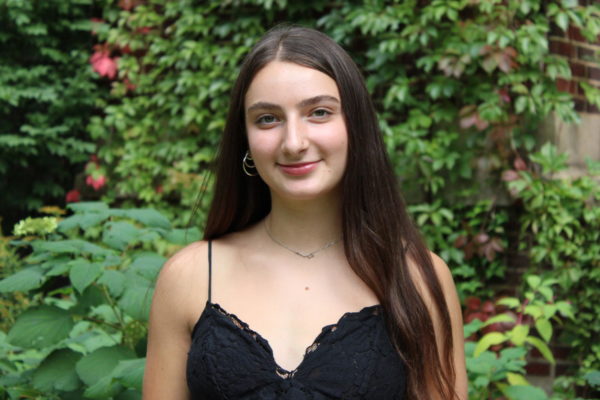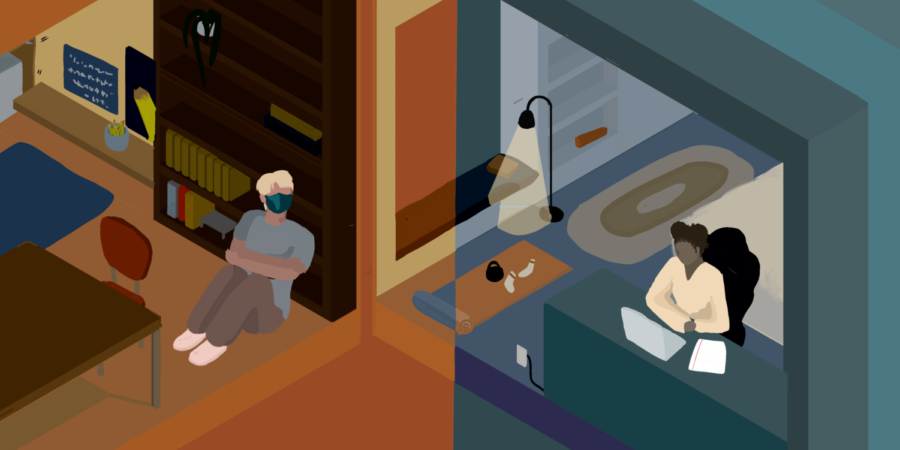Emotions run high during, after two-hour lockdown
At 10:16 a.m. on Thursday, Dec. 16, the ETHS building went into hard lockdown, signifying a present threat in the building, resulting in staff and students hiding and locking the doors to all classrooms. At 12:39 p.m., the lockdown was lifted and students were dismissed for the rest of the school day. An email later in the evening from superintendent Eric Witherspoon explained that two loaded handguns were confiscated off of students during an incident involving marijuana, which led to the school entering lockdown. Although there were no injuries or fatalities, the situation evoked a multitude of contrasting emotions in students.
“For me, it was just fear the entire time,” junior Alice Lavan shares. “I think, at a certain point, I was just so overwhelmed and anxious, and the emotions had just built up so much that any good news wasn’t really going to make me feel better.”
Fear was a common emotion across many students, in addition to a surreal feeling. For some, their alarm did not strike them until after the initial lockdown announcement.
“At first, nothing felt real. I think the panic was starting to settle in for a lot of people right after the initial shock, but it took me until the all clear announcement to actually realize what had happened,” sophomore Gabriella Baichwal says. “My emotions were totally shock-based, and I think that was what was keeping me from really freaking out.”
For others, a sense of panic began much earlier on and faded over the course of the lockdown.
“I was super scared for about 15 minutes at the beginning. Then, I realized nothing was actually happening, and I was bored,” junior Anthony Orsi states.
That sense of boredom may stem from the prolonged length of the lockdown. Baichwal shares that by the end of the lockdown,—which lasted over two hours—her class felt “stir-crazy” and “on edge.” Students were in their classrooms for over two hours before the lockdown was lifted, which students have mixed opinions about.
“I’ve actually heard a surprising amount of people saying that they felt like it was an overreaction to put us into a lockdown for that long, and I disagree with that,” Lavan notes. “I think that, even though those hours and hours of sitting and waiting and hiding were after the police had found the guns, there was still a very real possibility that there was still a threat in the building. I think, in a situation like that, it’s so important to be extra cautious and extra thorough. Of course, that’s what our school and the Evanston Police Department did, and I’m grateful for that.”
In addition to noting feelings of gratitude towards those involved bringing the threat to a safe resolution, students felt that prior drills had prepared them for this unfortunate reality.
“I definitely felt prepared and like I knew what to do.Luckily, my class took it pretty seriously, and after the first few nervous jokes, people settled in. It was exactly like a drill, but the mood was super serious,” Baichwal shares. “I remember my teacher locking the door, checking it again, sitting back down and then getting up again to check it a third time. It was comforting knowing everyone was in the same boat and everyone was taking it seriously.”
In consideration with the amount of time students spent together in their classrooms, another form of stress was present during the lockdown. In the week leading up to that Thursday, ETHS experienced an immense uptick in COVID-19 cases, which may have contributed to the stress of students during the lockdown. By the end of the week, ETHS reported 129 new COVID-19 cases on its dashboard, up from 21 the week prior.
“With all of the COVID cases rising, it was stressful to be in a pretty small room with a bunch of people cooped up for a pretty long time,” Orsi shares.
With seeking shelter in a secure location, the role of COVID-19 did not remain at the forefront of many people’s minds.
“As you can probably imagine, the basketball gym is very open, so my teacher found an equipment closet for us to all go in. It was very dark, and I felt very safe in this closet. However, it was hard to be in silence for two-and-a-half hours in a dark, claustrophobic closet, especially given the rise in [COVID] cases,” junior Sophie Glantz shares.
Amidst the rapid spread of COVID-19 cases within ETHS, gathering in close quarters was the last thing the school needed. Others shared the lack of consideration they directed towards the possible spreading of COVID-19, and rather, focused the entirety of their attention towards their safety in regards to the lockdown.
“I wasn’t really thinking about COVID at that time. But I was definitely keeping my mask really high up and tried to be safe,” sophomore Andrew Gamauf says. “COVID wasn’t the first priority though.”
While COVID-19 may have been prioritized differently across various students, a common first priority for various students included reaching for their phones to communicate with their friends or loved ones.
“When I heard that alarm and that announcement, I immediately recognized the sound of the bell, and the very first thing that I did was [I] pulled out my phone and texted my best friend, and I just texted her ‘No’, because I think both of us were in complete, utter disbelief at the very beginning. This is something that both of us have thought a lot about, and it’s a very real fear for both of us. I just couldn’t believe what was happening,” Lavan adds.
Baichwal’s experience mirrored that shock, but consistent posts by the EPD reassured students that the situation was being dealt with adequately.
“The vast majority of information we got was from our phones, and I think I would have a totally different opinion on how the situation was handled if I didn’t have all of the information at my fingertips as soon as it was available,” Baichwal shares.
Lavan shares that, later on, her phone died, which contributed to the stress she was feeling. This emulates the attitudes of various students, as a lack of access to communication and information surrounding the incident was a large factor driving their anxiety levels.
“My phone actually died within the first hour or 45 minutes, which felt like the absolute worst case scenario at the time, because it was before we had been getting updates from the EPD, so we really didn’t know what was going on, so that fear, from the uncertainty, was still there, and I lost my way to communicate with my parents and my friends, so that was really bad,” Lavan continues.
For the greater ETHS student population, specifically those who were unable to receive updates individually, they relied heavily on the administration for information. Some felt that the school could have handled the communication aspect in a more timely manner.
“I think Dr. Witherspoon did a good job of telling us that we were all safe, but he did tell us that pretty late. I think they should have told us what was going on right after, because they arrested the people, and then they didn’t say anything for like an hour,” Orsi shares. “That didn’t really make sense; maybe it was a legal thing, I have no idea, but I think [ETHS] did a pretty good job [of handling the situation].”
Contrary to Orsi’s feelings in regards to the handling of knowledge, others feel as though the lockdown was dealt with seamlessly, and the announcements took away any lasting uncertainty.
“I think the school handled it perfectly. I think they brought the police in and called a lockdown at the correct time. ETHS took their time to ensure safety which I appreciated,” Gamauf says.
Given the recent rise in school shootings, many students felt a heightened sense of anxiety.
“The Oxford school shooting definitely affected how I was feeling, because my mind kept drifting to the experiences of other people. It didn’t feel real to me at the moment, because you always hear about this kind of thing happening to other people and you never think it’ll happen to you,” Baichwal admits. “Trying to imagine what those students must’ve been feeling (during and after) is so difficult because I’m still shaken up from Thursday and no one was even injured.”
Baichwal’s remaining reaction surrounding the lockdown is not an isolated experience. Many students, like Baichwal, have recalled an unresolved emotional response regarding the lockdown.
“I definitely have lasting feelings and emotions after that lockdown, and I’ve talked to a lot of people about this. I’m noticing that we all have, collectively, the tendency to invalidate ourselves and compare our experiences to other people and other schools. It is very important to acknowledge that we didn’t have an active shooter, [and] we didn’t have fatalities or injuries. [However], we still had those two [to] three hours of uncertainty and fear, and the fact that it ended well, which I know we’re all so grateful for, doesn’t make the waiting and the hiding any less scary,” Lavan says.
Although the lockdown was a shared experience for students, the emotional aspect that comes with it can manifest itself uniquely in different students. Much like how emotions vary across students, the time period to address and cope with those emotions may contrast in students as well.
Lavan concludes, “The fact of the matter is, it was a really traumatizing school-wide event that we all experienced, and I think we all have to allow ourselves room and time to process it. Just because no one was hurt and no shots were fired and it ended well doesn’t mean you have to be okay with it. I’m not okay with what happened. That feeling of fear lasted with me for the next day, maybe two. It was a big thing, and we have to let ourselves feel that.”
Your donation will support the student journalists of the Evanstonian. We are planning a big trip to the Journalism Educators Association conference in Nashville in November 2025, and any support will go towards making that trip a reality. Contributions will appear as a charge from SNOSite. Donations are NOT tax-deductible.











